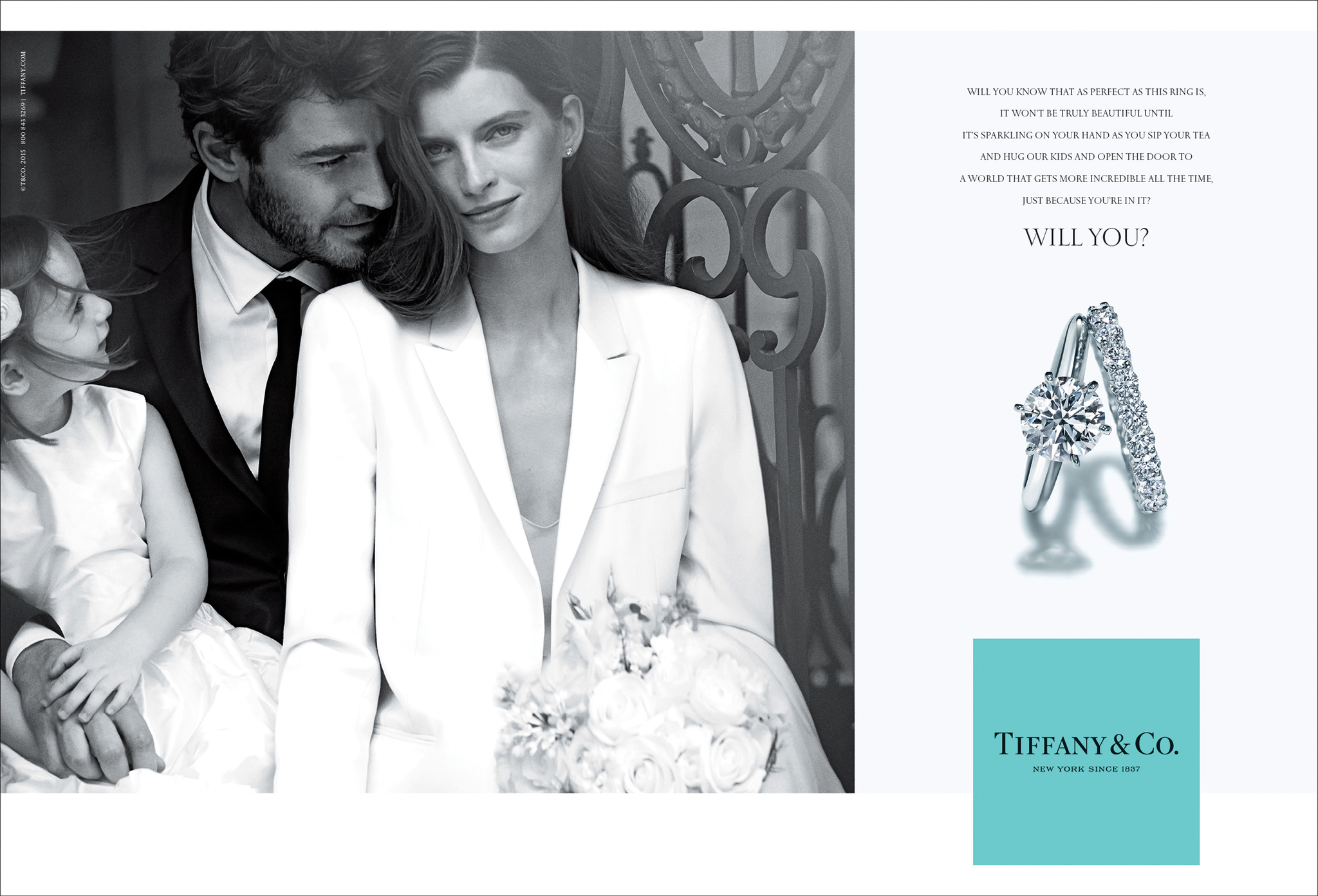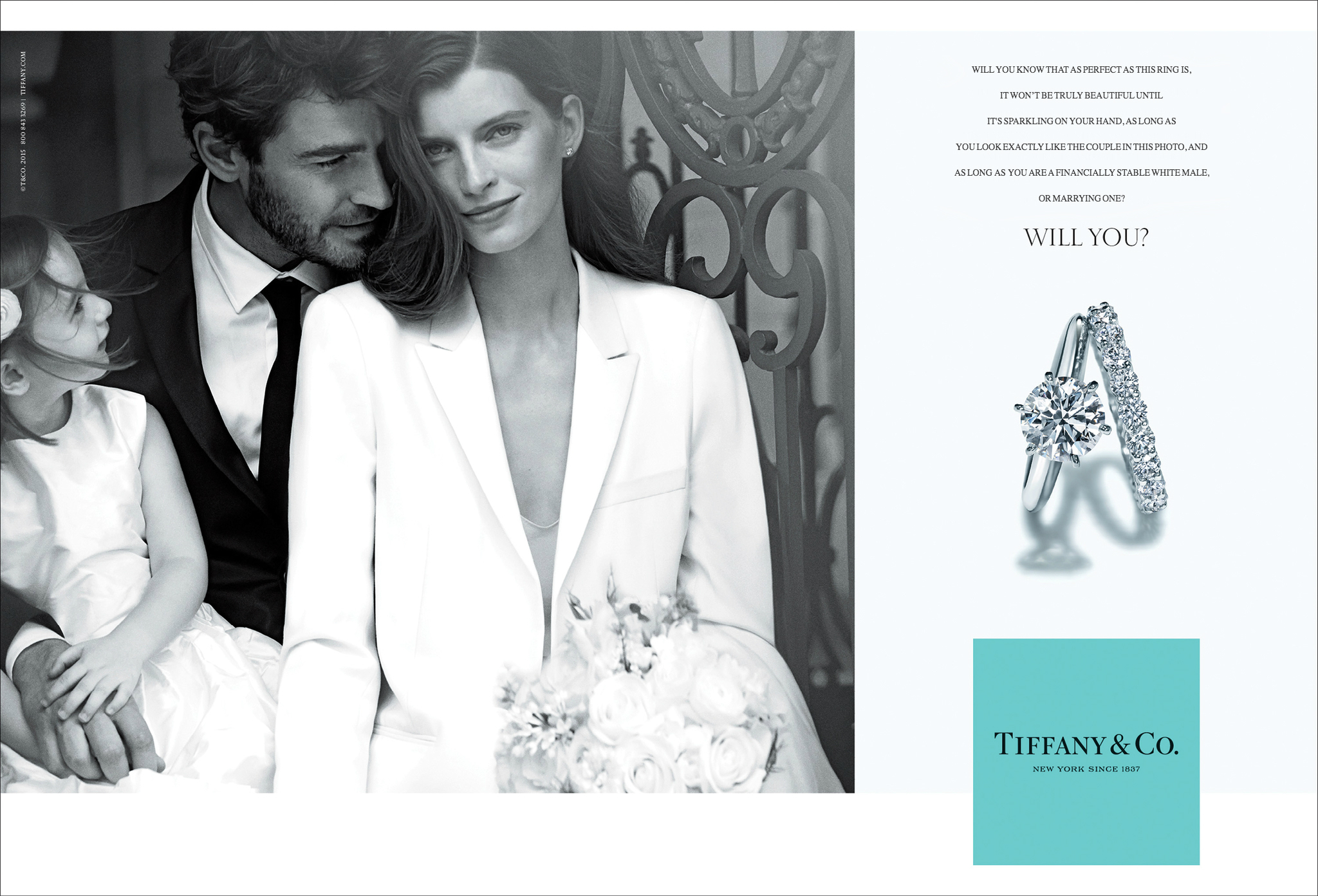
Analysis of One of Tiffany & Co’s original “Will You?” Advertisements: Beautiful or Exclusive?
The term “Culture Jamming” is the use of drawing attention to how the media and corporations affect everyday lives and views both consciously and sub-consciously, by instilling mock reworks to defamiliarize the original advertisement (i.e. billboard, commercial, etc.) in order to display its true subliminal meaning (Dery 2010). The advertisement I chose to deconstruct above is part of a campaign series titled “Will You?” by Tiffany & Co., presenting their new line of engagement rings. The campaign features primarily white men, and despite having a same sex couple (both white and male) and one interracial couple (white male and African-American female), each one has a white male as one of the focal points, inadvertently showcasing the white male as a symbol of power and what is “normal” (especially due to western and euro-centric beliefs and colonial history), evidently missing intersectional identities (i.e. LGBTQ+ people of colour couples, an advertisement without at least one white person, etc.). The particular advertisement I chose from the series portrays a white hetero-normative couple with a daughter, which suggests the ideal of the “white-picket fence” and “nuclear family.” Upon analyzing the campaign, it suggests that the target consumer audience is white males, and what can be deducted from the images, as well as Tiffany & Co.’s reputation for high prices and elegance, is that they are assuming that white males (all groomed and clad in suits or business wear within the photos) are of high income and socio-economic stability. This particular ad references how the ring is “perfect”, however it is not “truly beautiful” until it is “sparkling on [the woman’s] hand as she … hug[s] [their] kids.” The picture and the quote reinforce the ideal of engagement, marriage, and having a family, portraying white hetero-normative stereotypes. Tiffany & Co. further markets the aforementioned ideal to young consumers, especially those in their “teenage” years, who see images like these ones perceived as ‘normal’, which then “socially controls” and “manipulates” them through what the mainstream and dominant society chooses to display (Dery 2010). Furthermore, as James Gleick mentions in his article about the “meme” with reference to Dawkins, is that because of social conditioning (particularly by the media), people, particularly vulnerable audiences (due to age, class, gender, etc.), feel the need to “imitate” what they are seeing because the idea or ideal being presented to them constantly fights to stay dominant in mainstream society (Gleick 2011). Thus, such a representation within this Tiffany & Co. advertisement (and its whole campaign) may cause anyone who is questioning their own identity, whether due to race, class, gender, sexuality, or even socio-economic status (as Tiffany & Co. rings are very expensive), to feel insecure and as if they are not normal, positioning them within a diaspora not accepted in contemporary society.

Jamming Philosophy and Alteration of One of Tiffany & Co.’s “Will You?” Advertisements: What Tiffany & Co. is Truly Marketing
Within the culturally “jammed” version I created above to replicate the Tiffany & Co. advertisement, the message I choose to invoke takes the original advertisement’s quote about the beauty of the ring not sufficing unless it is on the wife’s hand as she hugs their (the couple’s) child, and showcases its true intentions while utilizing similar language to the original ad. I alter the message to expose how the ring will be “beautiful”, so long as the consumer mirrors the white hetero-normative couple with the goal of marriage and children, which simultaneously features a white financially-stable patriarch. The original message on the advertisement touches on how the world will get “better every day” as the ring “sparkles” on the woman’s hand just because she is in it, making the positive idealistic “future” painted for the couple sound easy. However, my jammed version of the advertisement ‘agrees’ that obtaining the perfect ring and life is ‘easy’, as long as one’s class, socio-economic status, stereotypical “nuclear family” ideals, sexuality, gender, and race, matches that of the family portrayed in the photo. If the consumer does not, then the ring (nor the life) is not for them. By blatantly transforming the language to that of satirical and obnoxious (possibly even accusatory), I hope to transform the suggestively ‘beautiful’ and ‘idealistic’ language utilized in the original advertisement that possibly invokes social conditioning, conformity, and insecurity to persons who fit and do not fit into the criterion (Gleick 2011). Through jamming the original message, it then exposes the true agenda that corporations, such as Tiffany & Co. who (being a diamond mining company) has a reputation for exploitation of natural resources, environments, and labour (Inveen 2016), has, and who their target audience truly is. Through deconstruction, which is “the critique of the relationship between text and meaning” (Wikipedia) of the advertisement, its revelation then showcases how dominant society seeks to maintain the status-quo, which then forces the consumer to critically-think about who is deemed as “superior” in society. In this case, anyone who reproduces and imitates the dominant ideologies (marriage, heterosexual, white supremacy) is deemed superior, which is who Tiffany & Co. arguably markets to, versus those deemed inferior (i.e. non-white, non-heterosexual, etc. populations) that they suggestively, in contrast, do not represent, nor market for.